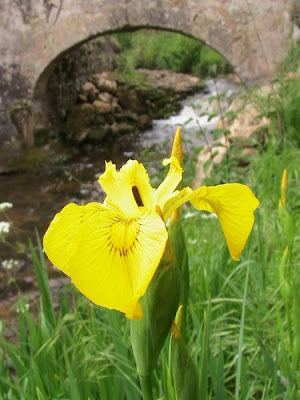
'Green' has been a subject that has frequently popped into my conversations lately. Not long ago a fellow artist and I were discussing the use of this colour in our work and just how difficult mixing pleasing and harmonious shades, tones and hues of green can be. There is a belief that ‘green’ paintings, in general do not sell as well as those predominantly in other hues and I can understand why; there are few colours that are uglier to me than an ugly green!
When I was growing up I loved green with a passion, I even had a bedroom painted an excruciatingly ‘acid’ shade of lime green for a while. That green, along with a strident pink and an equally robust orange formed one of the key palettes of the late sixties and I’m sure this explosion of colour led to the fondness for the browns and creams of the seventies. But I digress! Back to green…still a singularly favourite colour but now just one of many!
For the past few days, I have been driving via the coastal route to the little village of Strachur, fifteen miles north up the loch. This is the direction from which we came when we first viewed our new home but because the other route over the hills is quicker for shopping, that is the one we usually use.
The first impression along this coastal road is green, green and more green…dappled, mossy, shiny, soft green, every hue and tone imaginable. I begin my journey on the typical loch-side drive; a single tarred ribbon with pastures one side and glistening water on the other. Across the water, the hills on the other side rise from the shore in puffy, patchwork patterns; a kaleidoscopic crazy quilt of soft greens tossed over a rocky frame.

Just a short distance on, the ribbon plunges into deep green tunnels through the forest lit by thousands of tiny shafts of sunlight. If you were to pause, pull over and switch off the engine, the only sound would be the distant rushing of a small burn as it tumbles away to the loch.
Continuing again, the road winds imperceptibly upwards as it wends around a hill and as suddenly as it began, the tunnel gives way to a feathery corridor open to the sky. Silver Birch, Rowan, willow, beech and ash line the route with scented honeysuckle dripping down here, there and bracken and ferns everywhere. As you climb, the undulations become more apparent and rounding a corner, you find you’re on a mountainside with stone walls holding the edges from dropping down to miniature beaches below.
And so it goes, repeating this pattern over and over many times until the narrow track meets the main road some twelve miles on. Here and there are clumps of tall yellow flag iris, an occasional pink wild rose, an ivy covered stump or two, mounds of purple rhododendrons and many smaller wildflowers I’ve yet to name. Sometimes the vegetation clears and the tiny stony beaches show themselves and sometimes other inhabitants; a family of oystercatchers strolling along surprise me on a small stone bridge while further on, two rabbits dart across the road. Civilisation is represented in the handful of dwellings along the way, cottages and wooden cabins, and lastly passing through the edge of one of the old estates, a few family houses. They signal the beginning of the end! A half an hour or so has passed when the road swings away from the loch and continues over a heather clad hillside only to end abruptly at the highway. Three miles along this modern artery takes me into Strachur, forty-plus more and I would be in Glasgow, Scotlands' largest city!
And so it goes, repeating this pattern over and over many times until the narrow track meets the main road some twelve miles on. Here and there are clumps of tall yellow flag iris, an occasional pink wild rose, an ivy covered stump or two, mounds of purple rhododendrons and many smaller wildflowers I’ve yet to name. Sometimes the vegetation clears and the tiny stony beaches show themselves and sometimes other inhabitants; a family of oystercatchers strolling along surprise me on a small stone bridge while further on, two rabbits dart across the road. Civilisation is represented in the handful of dwellings along the way, cottages and wooden cabins, and lastly passing through the edge of one of the old estates, a few family houses. They signal the beginning of the end! A half an hour or so has passed when the road swings away from the loch and continues over a heather clad hillside only to end abruptly at the highway. Three miles along this modern artery takes me into Strachur, forty-plus more and I would be in Glasgow, Scotlands' largest city!

All this abundance of natural beauty owes a lot to the fact that the Highlands are the wettest area of the UK with the annual rainfall averaging more than a 120 inches (3000 mm)! The area of South Africa where we lived was also very lush and beautiful for three or four months of the year. In fact some places are so similar to Scotland that many Scottish immigrants chose to live there after the dust from the Boer War had settled, in the beginning of the last century. But whereas Scotland goes from green to greener and flowering, in Africa all that greenness fades to fawn until the next rainy season. The big difference is that the rainfall in Mpumalanga* (the old Eastern Transvaal) averages under 40 inches (1000mm) annually, only a third of or less than Scotland.
*For those adventurous enough to try, this is pronounced something sounding like mmm-poo-ma-lung-ga which means ‘the place where the sun rises’ in the languages of siSwati and Zulu.
